
Life can hand us plenty of frights, flights and fears but it’s good to look back occasionally to see how far you’ve come. I’ve been reflecting on this over the weekend when I noticed some old fears resurfacing, and rather than get caught up in the stories they told me, I chose to look at how far I’ve progressed.
I was eager to get back on my mountain bike after a couple of weeks away road tripping, bushwalking and trail running which I absolutely loved, but I also love riding my bike and 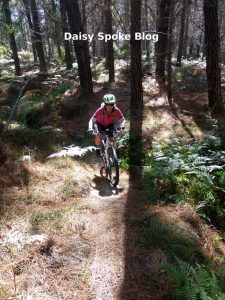 was missing it. When I started riding on the weekend, I noticed some of those old worries pop up that only surface when I’ve been off my bike for a while. They used to hang around me a lot. Well actually, most of the time! But I’ve worked really hard at keeping them in their place in recent years. Deciding to blog about them has been one of the most empowering actions I’ve taken. They could no longer lurk away in the dark depths of my mind, stewing and multiplying and expanding by the minute. Many of them simply lost their power when I brought them out into the light of day. Have you read my blog about how I worked through a step-by-step process to manage my fear of “the scary corner”!
was missing it. When I started riding on the weekend, I noticed some of those old worries pop up that only surface when I’ve been off my bike for a while. They used to hang around me a lot. Well actually, most of the time! But I’ve worked really hard at keeping them in their place in recent years. Deciding to blog about them has been one of the most empowering actions I’ve taken. They could no longer lurk away in the dark depths of my mind, stewing and multiplying and expanding by the minute. Many of them simply lost their power when I brought them out into the light of day. Have you read my blog about how I worked through a step-by-step process to manage my fear of “the scary corner”!
So here I was on Sunday morning with an incessant barrage of inner talk going on in my head:
“That’s too slippery.”
“I can’t ride down that gully.”
“I’m going to hit that tree.”
“I’m hopeless at riding on ‘technical’ terrain.”
“My back tyre keeps slipping out. I can’t ride up here.”
“There are too many rocks.”
“There are too many low hanging branches.”
“I have to go slowly round this corner so I don’t fall off.”
“I’d better walk this bit.”
“That’s where I fell before.”
“That’s another place I fell off.”
“That’s where I nearly fell on the snake when I stopped too quickly and went over the handlebars.”
…..and so on and so on. It was very loud in my head!
NOW I want to say that the most powerful step YOU can take if you find yourself in a similar situation is simply this: NOTICE what’s going on in your head. Simply NOTICE. The situation doesn’t’ have to be about riding a bike. It might be the thoughts you have associated with speaking to an audience, introducing yourself to someone, going out in the dark, driving in the city traffic, swimming with sharks, flying on a plane, or absolutely anything at all! Simply NOTICE what your mind says. And with the power of noticing what’s going on in your head, you can then choose what to do next.
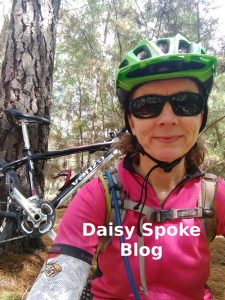 I’ve been practising and teaching this technique for a lot of years, and yet still I sometimes forget to do it when the moment arises. The thing is that on Sunday morning I DID NOTICE those fearful thoughts bouncing round my head. And guess what? I didn’t care about them. I didn’t let them bother me. Instead of giving them the power of my attention and allowing them to expand and bully me into playing it too safe, I chose to dig up another thought from my mind vault:
I’ve been practising and teaching this technique for a lot of years, and yet still I sometimes forget to do it when the moment arises. The thing is that on Sunday morning I DID NOTICE those fearful thoughts bouncing round my head. And guess what? I didn’t care about them. I didn’t let them bother me. Instead of giving them the power of my attention and allowing them to expand and bully me into playing it too safe, I chose to dig up another thought from my mind vault:
“This is a confidence cycle. I only worry about these things when I’ve been off my bike for a couple of weeks and out of practice. Just ride. Focus on how far you’ve come over the past few years. Don’t let those worries bully you or keep you small, or limit the fun you’ll have today. You’re sensible. You won’t do any crazy dangerous stuff. You’re safe. Just ride.”
And so I focused on how strong I felt and that all the recent running has made a positive difference to my strength and aerobic fitness. I enjoyed the feeling of sprinting up a couple 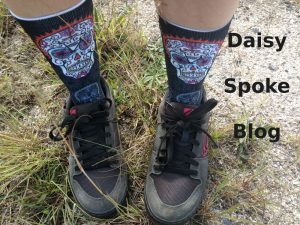 of short hills engaging my quads in an exertion that a couple of years ago would have been painful (if not impossible)! I pedalled in a higher gear than normal and found it easier than expected. I noticed what I did well and trusted wholeheartedly that my confidence will be back real soon. I glanced down at my fabulous new “tough girl” socks reminding myself of my strengths and the stories I can tell myself about what I CAN do. And as I looked back over the past few years, I could see how far I’ve progressed in managing my fears on the bike. I’ve developed resilience and practised some of life’s most valuable skills that I’ve transferred into other areas of my life.
of short hills engaging my quads in an exertion that a couple of years ago would have been painful (if not impossible)! I pedalled in a higher gear than normal and found it easier than expected. I noticed what I did well and trusted wholeheartedly that my confidence will be back real soon. I glanced down at my fabulous new “tough girl” socks reminding myself of my strengths and the stories I can tell myself about what I CAN do. And as I looked back over the past few years, I could see how far I’ve progressed in managing my fears on the bike. I’ve developed resilience and practised some of life’s most valuable skills that I’ve transferred into other areas of my life.
Yes, frights, flights and fears will always be there, but you can choose how to handle them. Practise. Persist. And occasionally look back to see how far you’ve come.
Discovering mountain biking as life’s ultimate parallel universe in her middle age,  Kathryn Walton shares information and reflections in Daisy Spoke that connect, inspire and self-empower women to make healthy choices for themselves. She integrates her love of physical exercise, family, nature, gardening and creative arts with her professional background in mental health social work to facilitate change with individuals, groups and communities of women who are committed to living life to the full.
Kathryn Walton shares information and reflections in Daisy Spoke that connect, inspire and self-empower women to make healthy choices for themselves. She integrates her love of physical exercise, family, nature, gardening and creative arts with her professional background in mental health social work to facilitate change with individuals, groups and communities of women who are committed to living life to the full.
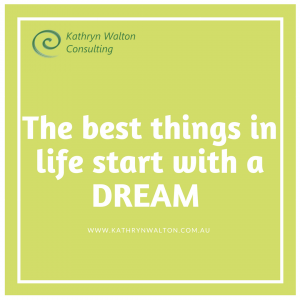
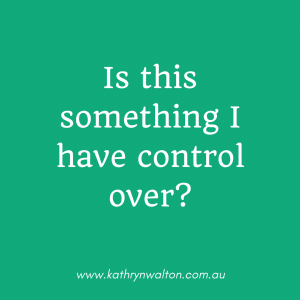


 Donna Neale-Arnold was my co-facilitator and special advisor at our recent retreat. She shared her w
Donna Neale-Arnold was my co-facilitator and special advisor at our recent retreat. She shared her w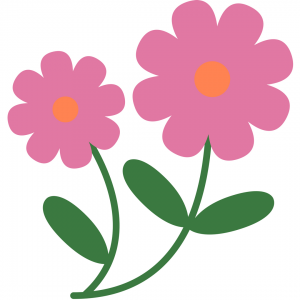 Click here to read my last blog post
Click here to read my last blog post 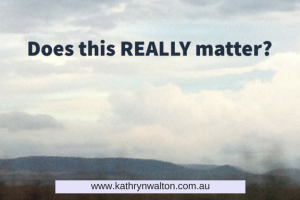
 example of mine was
example of mine was 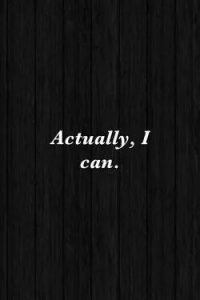
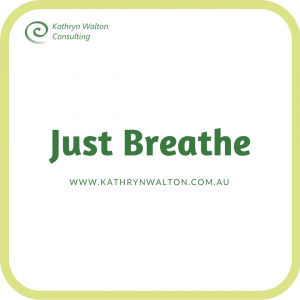 You can collect them from songs, poems, books and social media in addition to listening to your own inner wisdom. Write them on sticky notes, in a journal or diary, print out visual reminders to stick around your home or workplace, or even use them as screen savers and wallpapers on your electronic devices. Some examples include “Just do it”, “One drop raises the ocean”, “Keep it simple”, “Just breathe”, “Stand tall”.
You can collect them from songs, poems, books and social media in addition to listening to your own inner wisdom. Write them on sticky notes, in a journal or diary, print out visual reminders to stick around your home or workplace, or even use them as screen savers and wallpapers on your electronic devices. Some examples include “Just do it”, “One drop raises the ocean”, “Keep it simple”, “Just breathe”, “Stand tall”.
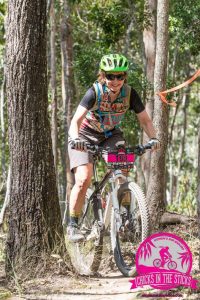 lying on the beach, your stresses trickling away into the sand beneath you) or to help you progress towards a goal (eg visualise yourself speaking in front of an audience, feeling confident, upright posture, smiling, relaxed). When I’m feeling nervous about riding my bike on a particular section of track, I stop for a few moments and picture myself riding it the way I want it to go, as if I’m watching a short video of myself successfully negotiating that section. It truly is a powerful mind-based strategy and one you can use in every area of your life.
lying on the beach, your stresses trickling away into the sand beneath you) or to help you progress towards a goal (eg visualise yourself speaking in front of an audience, feeling confident, upright posture, smiling, relaxed). When I’m feeling nervous about riding my bike on a particular section of track, I stop for a few moments and picture myself riding it the way I want it to go, as if I’m watching a short video of myself successfully negotiating that section. It truly is a powerful mind-based strategy and one you can use in every area of your life.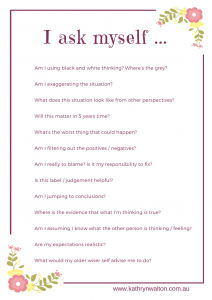 the mix. And to help you keep your strategies in play, I’ve created a free printable for you. “I ask myself …” is a beautiful keepsake of the helpful questions listed above. You can
the mix. And to help you keep your strategies in play, I’ve created a free printable for you. “I ask myself …” is a beautiful keepsake of the helpful questions listed above. You can 
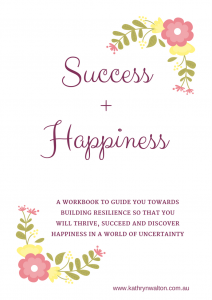 I have an EXCITING OFFER for you!
I have an EXCITING OFFER for you!

 Kathryn Walton shares information and reflections in Daisy Spoke that connect, inspire and self-empower women to make healthy choices for themselves.
Kathryn Walton shares information and reflections in Daisy Spoke that connect, inspire and self-empower women to make healthy choices for themselves.
 for Chicks in the Sticks. I had every intention of training even better than last year. However ….. life happened! In fact, a lot of life has happened over the past few months and I find myself now only 5 days away from the actual event with basically no preparation, less riding than normal, and still fighting off influenza. Cough, cough.
for Chicks in the Sticks. I had every intention of training even better than last year. However ….. life happened! In fact, a lot of life has happened over the past few months and I find myself now only 5 days away from the actual event with basically no preparation, less riding than normal, and still fighting off influenza. Cough, cough.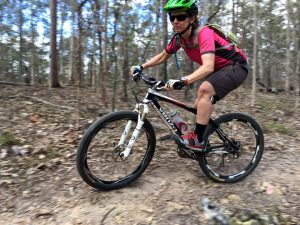 bothered” and “I’m not good enough” thoughts that only serve to make me feel bad. They don’t change the reality, the things I don’t have control over. Giving in to those thoughts doesn’t change my sense of commitment or my intention.
bothered” and “I’m not good enough” thoughts that only serve to make me feel bad. They don’t change the reality, the things I don’t have control over. Giving in to those thoughts doesn’t change my sense of commitment or my intention. Against all odds, I’ll be at Chicks in the Sticks this weekend. My support team, including my own inner-compassionate-self, will be there too, reminding me of my intention to foster an element of fun and playfulness as I ride with up to a couple of hundred other chicks! What a blast!
Against all odds, I’ll be at Chicks in the Sticks this weekend. My support team, including my own inner-compassionate-self, will be there too, reminding me of my intention to foster an element of fun and playfulness as I ride with up to a couple of hundred other chicks! What a blast!
 There is growing concern for obesity and other conditions related to sedentary behaviour including chronic illness and poor mental health. Apart from the obvious burden on the nation’s economy, the real burden of poor health is lived out and carried everyday by individuals, families and communities. As a community, I believe we need to creatively explore the possibilities when it comes to getting people active, and not expect individuals to slot into the pre-existing boxes for engaging with physical activities.
There is growing concern for obesity and other conditions related to sedentary behaviour including chronic illness and poor mental health. Apart from the obvious burden on the nation’s economy, the real burden of poor health is lived out and carried everyday by individuals, families and communities. As a community, I believe we need to creatively explore the possibilities when it comes to getting people active, and not expect individuals to slot into the pre-existing boxes for engaging with physical activities.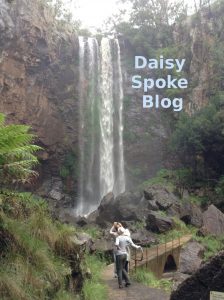 Rural and regional Australia has poorer health outcomes than its urban counterparts, so I’m really keen to make a constructive contribution to the health and wellbeing of my community on the southern Darling Downs, and to encourage women and girls to creatively construct systems and routines so they can enjoy being more active.
Rural and regional Australia has poorer health outcomes than its urban counterparts, so I’m really keen to make a constructive contribution to the health and wellbeing of my community on the southern Darling Downs, and to encourage women and girls to creatively construct systems and routines so they can enjoy being more active.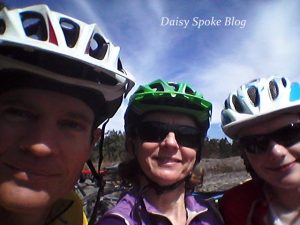 needs – not only women. Times they are a changin’ and the best time for change is now. I’d love to hear ideas from everyone regardless of gender:
needs – not only women. Times they are a changin’ and the best time for change is now. I’d love to hear ideas from everyone regardless of gender:
 So, what are these foundation stones of wellness? There are four main foundation stones that I work on with my clients as well as in my own personal life. Each of the stones support each other – they are interlinked – and they are a fabulous place to start building or renovating wellness at any time! The foundations are based on solid evidence that is routinely used in the mental health sector.
So, what are these foundation stones of wellness? There are four main foundation stones that I work on with my clients as well as in my own personal life. Each of the stones support each other – they are interlinked – and they are a fabulous place to start building or renovating wellness at any time! The foundations are based on solid evidence that is routinely used in the mental health sector. Basically, people are designed to move … a lot. When we don’t move enough, we are at greater risk of switching into a depressed or anxious state. It’s simple biology. Get moving, get active, get off the sofa, and move as much as you can and often as you can. For most of us it’s recommended to aim for about an hour of moderate intensity exercise or activity each day, and limit our screen time to 2 hours per day. The combined mental and physical health benefits of exercise / activity cannot be replaced by any medication. If you are in pain, or have limited movement, injuries, or chronic disease, the best idea is to do what you can. Remember always check with your doctor or health professional if you have any concerns about your health, exercise, and resting needs.
Basically, people are designed to move … a lot. When we don’t move enough, we are at greater risk of switching into a depressed or anxious state. It’s simple biology. Get moving, get active, get off the sofa, and move as much as you can and often as you can. For most of us it’s recommended to aim for about an hour of moderate intensity exercise or activity each day, and limit our screen time to 2 hours per day. The combined mental and physical health benefits of exercise / activity cannot be replaced by any medication. If you are in pain, or have limited movement, injuries, or chronic disease, the best idea is to do what you can. Remember always check with your doctor or health professional if you have any concerns about your health, exercise, and resting needs. 2. Sleep
2. Sleep 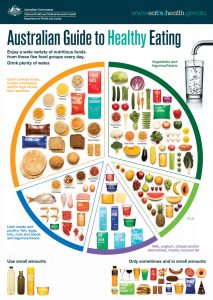 3. Nutrition
3. Nutrition  4. Mind
4. Mind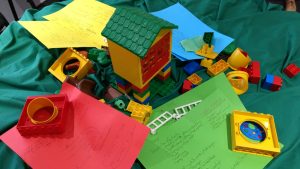
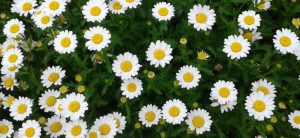
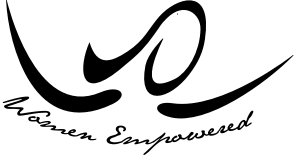 This tranquil day of RETREAT will have Kathryn Walton guiding a small group of women through reflections, discussions and creative activities as we explore the perceptions and experiences of barriers, obstacles, restrictions and limitations in our lives. Identifying and acknowledging these issues is a step towards EMPOWERING ourselves to step into the LIFE we want to live, the ATTITUDE we want to be living with, and the very real POSSIBILITIES this opens up for us. We want to do more than survive – WE WANT TO THRIVE!
This tranquil day of RETREAT will have Kathryn Walton guiding a small group of women through reflections, discussions and creative activities as we explore the perceptions and experiences of barriers, obstacles, restrictions and limitations in our lives. Identifying and acknowledging these issues is a step towards EMPOWERING ourselves to step into the LIFE we want to live, the ATTITUDE we want to be living with, and the very real POSSIBILITIES this opens up for us. We want to do more than survive – WE WANT TO THRIVE!